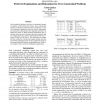Free Online Productivity Tools
i2Speak
i2Symbol
i2OCR
iTex2Img
iWeb2Print
iWeb2Shot
i2Type
iPdf2Split
iPdf2Merge
i2Bopomofo
i2Arabic
i2Style
i2Image
i2PDF
iLatex2Rtf
Sci2ools
AAAI
2004
2004
QUICKXPLAIN: Preferred Explanations and Relaxations for Over-Constrained Problems
Over-constrained problems can have an exponential number of conflicts, which explain the failure, and an exponential number of relaxations, which restore the consistency. A user of an interactive application, however, desires explanations and relaxations containing the most important constraints. To address this need, we define preferred explanations and relaxations based on user preferences between constraints and we compute them by a generic method which works for arbitrary CP, SAT, or DL solvers. We significantly accelerate the basic method by a divide-and-conquer strategy and thus provide the technological basis for the explanation facility of a principal industrial constraint programming tool, which is, for example, used in numerous configuration applications.
AAAI 2004 | Exponential Number | Important Constraints | Intelligent Agents | Principal Industrial Constraint |
| Added | 30 Oct 2010 |
| Updated | 30 Oct 2010 |
| Type | Conference |
| Year | 2004 |
| Where | AAAI |
| Authors | Ulrich Junker |
Comments (0)

